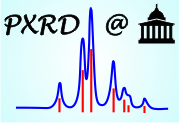 |
Data collection for qualitative PXRD |
 |
Data collection for qualitative PXRD |
Data Collection for Qualitative PXRD
PXRD data acquired for Qualitative Analysis is different to that collected for the purposes of:
PXRD Data Collection
Qualitative analysis places more emphasis on the intense peaks as these are the ones used for search-match. In a PXRD pattern, the most intense peaks usually occur at the lower scattering angles due to measurement geometry, the scattering of the atoms ("X-ray form factor"), and atomic displacement effects ("Thermal Vibrations"). Usually, there is no need to measure to high scattering angles for qualitative analysis (in contrast to collecting data for, say, unit cell refinement or Rietveld analysis). However, it is essential to start the measurement at the lowest 2θ angle possible (i.e. close to 0° 2θ) as the biggest d-spacing values are often very characteristic of a material; hence the biggest d-spacing value being highlighted at the top of the old printed-style cards. For qualitative analysis, experts in the field consider it bad practice to start at higher 2θ angles (e.g. 10° or even 20° in 2θ) in the (often mistaken) belief that their are no peaks of interest at lower angles. While a major phase of interest may be known to have it lowest angle peak above, say, 10° (or even 20°) in 2θ, it should never be assumed that there are no peaks due to another phase, such as an impurity phase from a chemical synthesis, at a lower 2θ angle. It should be noted that historically, it was a struggle for some PXRD instruments working in Bragg-Brentano reflection geometry to measure a PXRD pattern below 5° in 2θ. Hence, some of the classic textbooks on PXRD (e.g. Jenkins & Snyder) suggest starting the measurement at 5° for Cu Kα radiation instead of close to 0°. Depending on the requirements of the analysis, there is often no need for long data acquisitions, the notable exception being searches for impurity phases at low concentration.
Good sample preparation can be crucial for success in qualitative analysis. For example, overfilled flat-plate sample holders as used for Bragg-Brentano reflection geometry measurements will cause a systematic abberation in the position of the peaks as well as loss of peak intensity. It may be advisable to collect data with more than one geometry and on more than one instrument if there is uncertainty with regard to the reliability of peak positions and intensities.
Within the Department of Chemistry at UCL, several different types of instrument are available for PXRD qualitative analysis (and for other uses too). All of the high-resolution instruments can measure PXRD patterns from 0° in 2θ though the first 1.5° to 2° will be hidden by the beam stop; hence many scans start from 2° instead of zero though the time saved is negligible. The oldest instrument is a D500 Siemens diffractometer dating from the late 1980s equipped with a primary beam monochromator, Cu anode X-ray tube, and a scintillation counter as seen in the pictures below:
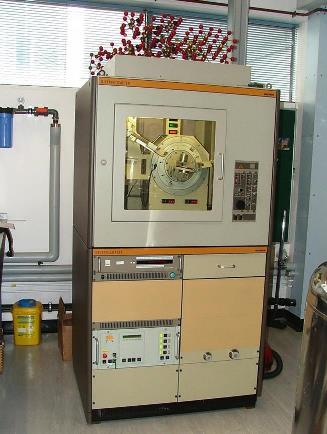
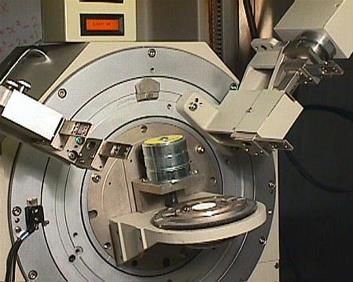
This instrument is very slow to collect data as the detector measure only one data point at a time (i.e. is a 0-dimension detector), but the instrument has a very low background and it can be used with Si-wafer holders for micro-analysis of PXRD samples. It can also be used with very fine slits to give very narrow peaks and with deep sample holders for block samples that are not amenable to grinding.
The next instrument below is the oldest Stoe diffractometer with a primary beam monochromator, Cu anode X-ray tube, and a 1-dimensional wire (gas-filled) detector as shown below.
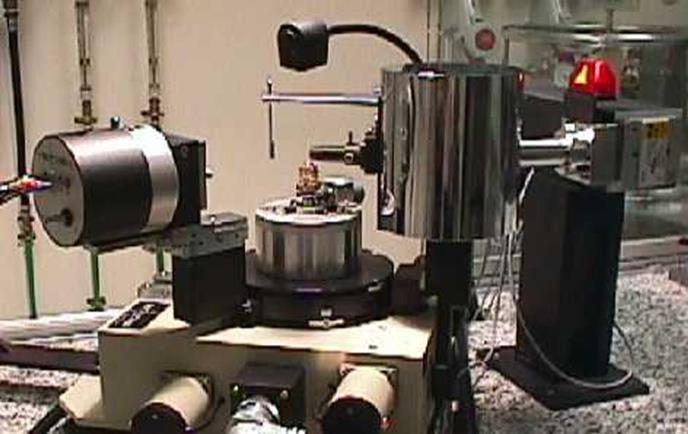
The setup uses capillariies and is ideal for organic/pharmaceutical type samples or for air-sensitive samples as long as they don't absorb X-rays too severely. However, the linear PSD covers a limited range of scattering angle and so is relatively slow.
The three newer Stoe instruments now have fast solid-state 1-dimensional silicon-strip detectors (called a Mythen1K®) as seen below on the Stoe setup with a Mo anode X-ray tube:
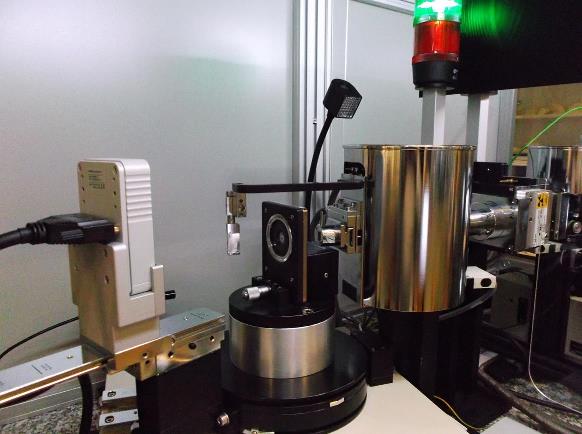
The use of Mo Kα1 X-rays avoids the fluorescence problem of using Cu X-rays on compounds containing a first row transition metal element. Samples may be run either flat-foil transmission (as shown above) or in a capillary (with a different central sample stage).
Data Collection Issues
PXRD data quality for qualitative analysis has similar requirements to that required for powder pattern indexing in that both require accurate d-spacing values. It is thus crucial to use well-aligned diffractometers whose alignement can be checked with external or internal standards, e.g. NIST Si or LaB6 powder. It is better to avoid set-ups with sample aberrations: for example, organic samples run on a diffractometer with Bragg-Brentano geometry may display systematic shifts in the position of the peaks to lower 2θ angles. There may be other issues with 2-dimensional samples, e.g. coatings on glass, metals, etc. where extreme preferred orientation affects are likely to be more common. Such samples are best measured on dedicated instruments, e.g. a grazing incidence (GI-PXRD) diffractometer.
|
|
|